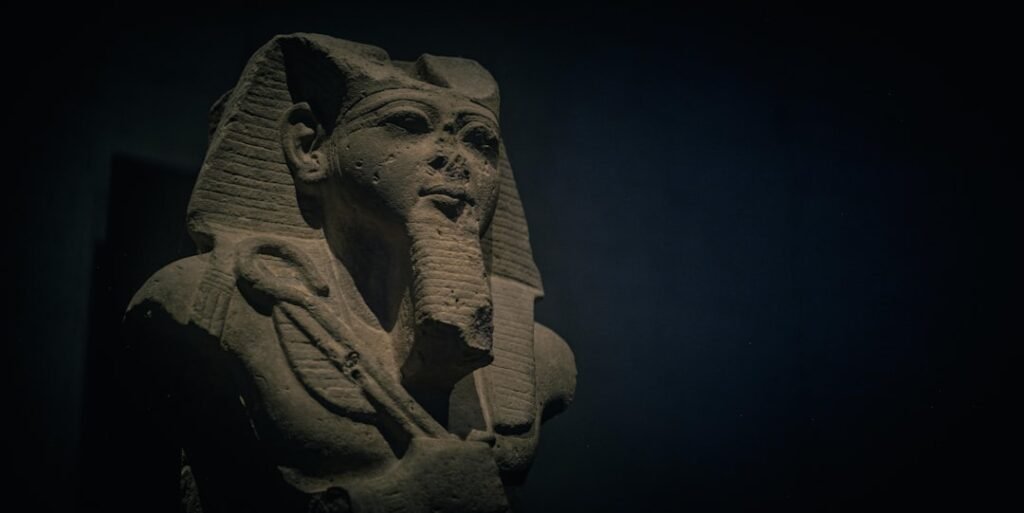Summary
- The Was Scepter, also known as the tcham-scepter, was a powerful emblem in ancient Egypt symbolizing dominion, divine authority, and magical force.
- It was often seen in the hands of gods like Set, Anubis, and Osiris, as well as pharaohs and priests, it played a vital role in religious rituals and funerary art.
- Its unique design, a staff topped with a desert animal’s head and a forked base, was believed to link the mortal world to the divine. Originating as early as the First Dynasty, it became a key tool in asserting control over chaos (isfet), maintaining universal order (maat), and ensuring safe passage to the afterlife.
- Crafted from wood, ivory, and precious materials, the Was Scepter’s symbolism endured through millennia, reinforcing the divine connection between rulers, gods, and the cosmos.
The was scepter a.k.a tcham-scepter is a symbol of power & dominion and an emblem of authority, plus it is associated with wealth and happiness, it was associated with ancient Egyptian gods like the god of chaos, desert and war, Set & the god of the dea,d Anubis plus it was found in the hands of ancient Egyptian pharaohs.
The Was specter represented the animalistic aspect of Set and the total takeover of the forces of chaos. It was believed that the staff had magical powers and was used to create a bond between the underworld and the mortal one. The “was” was an ancient Egyptian hieroglyph character representing power.
The Incredible Facts About the Was Scepter
- The Was specter was a symbol of the district of Thebes.
- The first depiction of a was-scepter dates back to Egypt’s First Dynasty.
- Its origins are thought to be linked to the heqa staff, traditionally used by Egyptian shepherds to guide and control their flocks.
- Symbolizing both dominion and well-being, the scepter was also regarded as a magical tool capable of battling the demons of the underworld.
- It was adorned with alternating bands of blue and gold.
- The was-scepter often appeared as a decorative element on funerary objects.
- While the length of the staff varied, it originally measured approximately six and a half feet (two meters).
- It was responsible in the funerary context for the well-being of the deceased, and often images of the symbol were found in the tomb equipment and on the decoration of the tombs and the coffins.
- The ancient Egyptians used the was specter as an amulet; they also perceived the sky as being supported on four pillars in the shape of a was specter.
- It was often combined with the Ankh and the Djed pillar in the hand of the god Ptah, who was known as the sculptor of the earth.
- The staff was also found in the hands of other gods like Hathor, Isis, Ra-Horakhty, and many others.
The Magnificent Origin Was Scepter
The scepter is in the shape of a staff with the head of a desert animal and an open fork at its base, which could symbolize the legs of this creature. Some believe that the origin of the staff can be derived from a walking stick, the root of a tree, a tent pole, or a fighting cane. The scepter’s association with divine rule may have been influenced by the belief that gods used such objects to maintain order (maat) and suppress chaos (isfet).
This ancient Egyptian symbol was very famous, heavily associated with gods like Anubis (god of mummification) and Osiris (god of the afterlife), reflecting its divine origins. It was constructed of wood, ivory, or faience, and sometimes precious metals like gold and silver were used. Its roots can date back all the way to the Predynastic period of ancient Egypt (before 3100 BCE) and continued to hold significance throughout the Pharaonic era, right into the Roman period.
It was commonly seen carried by Pharaohs, gods, and Priests during its first use in the first dynasty in the 30th century BC (3150 – 2613 BC) in the time of King Narmer. By the time of the Old Kingdom (2686–2181 BCE), the was-scepter had become firmly established as a symbol of divine kingship. Pharaohs, regarded as living gods, adopted the was-scepter as part of their regalia to underscore their divine authority.
Discover the Purpose of the Was Scepter
The Was Scepter served as massive mythological role, mostly in religious ceremonies and funerary art as it was featured in statues and as an image of the pharaohs, gods and goddess on ancient Egyptian temples & tombs holding the Was Scepter which emphasized their role in providing a safe passage for the deceased for the afterlife plus providing protection from any danger while crossing the underworld.
Every deity and Pharaoh made sure to carry the Was Scepter as a symbol of control, power, order, and dominion, plus represented the divine connection between them. Many believe they featured control over the elements, which explains why gods and kings carried them.
The Profound Power Behind the Was Scepter
The Was Scepter was believed to have multidimensional, cosmic power over time and space. It held power over life and death, plus provided a safe passage for every soul across the afterlife. The scepter had a powerful magical force harnessed from the gods to be used in maintaining ancient Egyptian magic and harmony in both the divine and mortal realms.
The scepter represents part of the might of the gods, which was bestowed on the rulers to signify their right to rule and their role to be the true intermediaries who will keep the balance between order (maat) and chaos (isfet), the was-scepter symbolized the ability to repel and subdue chaotic forces.









